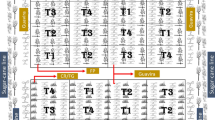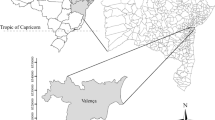Abstract
Despite the wide distribution of natural stands of Acacia senegal in Ethiopia, commercial exploitation of gum arabic is constrained by lack of tapping and development techniques. We evaluated the gum arabic yield from natural stands of A. senegal and the growth of 6 provenances in different parts of the country. For the gum yield evaluation from natural stands, four tapping positions and three tapping seasons were tested in a factorial RCB design. The second experiment in Metema evaluated survival and growth of six provenances. A. senegal trees in natural stands respond well to tapping if tapped during the appropriate season and at the correct position on the tree. The mean gum yield did not vary significantly by tapping season (p=0.63). Higher mean yield was, however, collected from trees tapped in October (96 g·tree−1 per two harvests). The mean yield differed significantly (p=0.009) between the tapping positions. Mean separation (α=0.05) shows that trees tapped at mid stem gave higher yield (160 g·tree−1 per two harvests). The interaction effect of tapping season and position was not significant. Higher mean yield ((70 ± 112) g·tree−1) was recorded in mid October-mid stem in two harvests. The second experiment indicated statistically significant difference in mean survival (p=0.0298), height (p=0.000) and root collar diameter (RCD), (p=0.012) between the six provenances. Highest survival, height and root collar diameter growth was observed from Abderafi provenance (100%, (148±11) cm, (38±11) mm, respectively). We recommend October and mid-stem and branches as appropriate tapping season and position. We recommend planting of the Abderafi provenance for the study area due to its superior growth and survival. Our study contributes to the proper selection of provenances for plantation development and improved tapping technology for better production of gum arabic in the country.
Similar content being viewed by others
References
Adam IM, Fadl EM. 2011. Determination of optimum tapping date for gum arabic production in South Kordofan State, Sudan. Journal of Forestry Research, 22(4): 685–688.
Albæk A. 1993. Tree Seed Zones for Ethiopia. Addis Ababa, Ethiopia: National Tree Seed Centre, p. 120.
Anderson DMW. 1990. Commercial prospects for gum exudates from the A. Senegal complex. Nitrogen Fixing Tree Res. Reports, 8: 91–92.
Azene B, Birnie A, Bo Tengnas. 1993. Use Full Trees and Shrubs for Ethiopia. Nairobi, Kenya: Swedish International Development Authority, p.474.
Ballal ME. 2002. Yield trends of gum Arabic from Acacia senegal as related to some environmental and managerial factors (PhD thesis). Khartoum: University of Khartoum, p. 105.
Ballal ME, El Siddig EA, Elfadl MA, Luukkanen O. 2005. Gum arabic yield in differently managed Acacia senegal stands in western Sudan. Agroforestry Forum, 63: 237–245.
Brenan JPM. 1983. Manual on Taxonomy of Acacia Species. Food and Agricultural organization, Rome, FAO, p. 55.
Cossalter C. 1991. Acacia Senegal: gum tree with promise for agroforestry. NFT Highlights, No. 91-02. Available at: http://www.winrock.org/fnrm/factnet/factpub/FACTSH/A_senegal.html [accessed on 10.02.2010].
Eshete A, Teketay D, Hulten H. 2005. The socio-economic importance and status of populations of Boswellia papyrifera (Del.) Hochst. in Northern Ethiopia: The case of North Gonder Zone. Forests, Trees and Livelihoods 15: 55–74.
Jøker D. 2000. Acacia Senegal. (L.) Willd. Seed Leaflet No. 5 September. Danida Forest Seed Centre. Available at: http://www2.sl.life.ku.dk/dfsc/pdf/Seedleaflets/Acacia%20senegal_int.pdf [accessed on 10.02.2010].
Lemenih M, Kassa H. 2011. Opportunities and challenges for sustainable production and marketing of gums and resins in Ethiopia. Bogor, Indonesia: Centre for International Forestry Research (CIFOR), p. 105.
Neumann RP, Hirsch E. 2000: Commercialization of Non-Timber Forest Products: Review and Analysis of Research. Bogor, Indonesia: Centre for International Forestry Research (CIFOR), p. 176.
Ræbild A, Hansen CP, Kjaer ED. 2002. Statistical Analysis of Data From Provenance Trials. Guidelines & Technical Notes No.63. Humlebaek, Denmark: Danida Forest Seed Centre, p. 22
Ross JH. 1979. A Conspectus of the African Acacia Species. Memoirs of the Botanical Survey of South Africa, 44: 55–58.
Tadesse W, Desalegne G, Alia R. 2007. Natural gum and resin bearing species of Ethiopia and their potential applications. Investigación Agraria: Sistemas y Recursos Forestales, 16(3): 211–221.
Author information
Authors and Affiliations
Corresponding author
Additional information
Fund project: This study was financed by the Ethiopian Institute of Agricultural Research.
Rights and permissions
About this article
Cite this article
Alemu, A., Yilma, Z., Eshete, A. et al. Growth performance and gum arabic production of Acacia senegal in northwest lowlands of Ethiopia. Journal of Forestry Research 24, 471–476 (2013). https://doi.org/10.1007/s11676-013-0378-1
Received:
Accepted:
Published:
Issue Date:
DOI: https://doi.org/10.1007/s11676-013-0378-1




